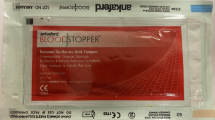Abstract
The primary function of nasal packs is to modulate the bleeding, prevent adhesions and obstruction, with least discomfort to the subjects without risking secondary infection. However, both packing and removal of the pack is an unpleasant experience, with the latter being extremely painful. Therefore the need of the hour is a dressing which prioritizes subject comfort without compromising other desired nasal pack properties. Twenty subjects were enrolled in this interventional, open label study. The subjects had 10 hospital visits, starting from baseline (Visit 1) to postoperative day 28 (Visit 10), at regular intervals. The proportion of the population with postoperative pain alleviation and bleeding control failure (within 10 min) were the main objectives. Within 10 min of VELNEZ administration, all 20 participants got their bleeding under control. With VELNEZ, the painful nasal pack removal method was totally avoided because it was biodegradable. No moderate/severe pain, infection and adhesions were reported in any of the subjects, but few subjects reported moderate obstruction until Visit 3 (Discharge Day). In the present study, for participants undergoing nasal surgery, VELNEZ proved to be a secure and reliable nasal pack.
Trial Registration: CTRI/2021/09/036437, prospectively registered.




Similar content being viewed by others
References
Joshi RR, Nepal A, Chhetri ST, Bhandary S, Panta TB, Regmi D (2012) An evaluation of merocel and neosporin impregnated ribbon gauze packs in patients following nasal surgery: a prospective randomised trial. Health Renaiss 10(1):30–34
Manea C, Sabaru I, Sanda C (2011) Nasal packing in endonasal surgery-a literature review. Rom J Rhinol 1(4):210–214
Kim YS, Kim YH, Kim NH, Kim SH, Kim KR, Kim KS (2011) A prospective, randomized, single-blinded controlled trial on biodegradable synthetic polyurethane foam as a packing material after septoplasty. Am J Rhinol Allergy 25(2):e77–e79
Kameswaran M, Raghunandhan S, Thomas JK (2014) A prospective double-blinded randomized controlled study comparing the efficacy of a novel biodegradable synthetic polyurethane foam (Nasopore) vs standard polyvinyl acetate sponge (Merocel) as packing material after functional endoscopic sinus surgery: the first Indian experience. Int J Clin Rhinol 7(3):105–111
Mane RS, Patil B, Mohite A (2013) Comparison of septoplasty with and without nasal packing and review of literature. Indian J Otolaryngol Head Neck Surg 65:406–408
Basha SI, Gupta D, Kaluskar SK (2005) Routine nasal packing follwoing nasal surgery—Is it necessary? Indian J Otolaryngol Head Neck Surg 57:69–71
Kennedy DW, Zinreich SJ, Rosenbaum AE, Johns ME (1985) Functional endoscopic sinus surgery: theory and diagnostic evaluation. Arch Otolaryngol 111(9):576–582
Iqbal IZ, Jones GH, Dawe N, Mamais C, Smith ME, Williams RJ, Kuhn I, Carrie S (2017) Intranasal packs and haemostatic agents for the management of adult epistaxis: systematic review. J Laryngol Otol 131(12):1065–1092
Mehan R, Varghese L, Kurien R, Jeyaseelan V, Rupa V (2018) Is nasal packing essential after functional endoscopic sinus surgery? A randomized, controlled trial. Int J Clin Rhinol 10(3):113–119
Ivanova PP, Iliev G (2023) Nasal packing in septal surgery: a narrative review. Cureus 15(3):24
Comer BT, Alfonso KP, Doyle EJ III, Gallogly JA, Simpson MC, Antisdel JL (2019) Analysis of absorbable hemostatic packing compared to physiologic hemostasis in functional endoscopic sinus Surgery with or without septoplasty. Am J Rhinol Allergy 33(5):531–539
Wang J, Cai C, Wang S (2014) Merocel versus nasopore for nasal packing: a meta-analysis of randomized controlled trials. PLoS ONE 9(4):e93959
Wang TC, Tai CJ, Tsou YA, Tsai LT, Li YF, Tsai MH (2015) Absorbable and nonabsorbable packing after functional endoscopic sinus surgery: systematic review and meta-analysis of outcomes. Eur Arch Otorhinolaryngol 272:1825–1831
Woodworth BA, Chandra RK, LeBenger JD, Ilie B, Schlosser RJ (2009) A gelatin-thrombin matrix for hemostasis after endoscopic sinus surgery. Am J Otolaryngol 30(1):49–53
Tran QK, Barnett J, O’Connell F, D’Anza B, Pourmand A (2021) Nasal packing in the emergency department: a practical review for emergency providers. Open Access Emerg Med 2:527–533
Razali RA, Vijakumaran U, Fauzi MB, Lokanathan Y (2023) Maximizing postoperative recovery: the role of functional biomaterials as nasal packs—A comprehensive systematic review without meta-analysis (SWiM). Pharmaceutics 15(5):1534
Baumann A, Caversaccio M (2003) Hemostasis in endoscopic sinus surgery using a specific gelatin-thrombin based agent (FloSeal). Rhinology 41(4):244–249
Park DY, Chung HJ, Sim NS, Jo KH, Kim DH, Kim CH, Yoon JH (2016) Comparison of calcium alginate and carboxymethyl cellulose for nasal packing after endoscopic sinus surgery: a prospective, randomised, controlled single-blinded trial. Clin Otolaryngol 41(3):234–240
Funding
Funding was provided by datt mediproducts.
Author information
Authors and Affiliations
Corresponding author
Ethics declarations
Conflict of interest
There is no conflict of interest for Dr Akhil Pratap Singh, Dr Saloni Singh, Dr Ridhima Malik and Dr Ritu Gupta. Dr Siddharth Pandey is the Head of Research and Development and Vice-President at Datt mediproducts, the manufacturer of VELNEZ nasal pack. VELNEZ is the product under study in this research.
Human and animal rights
Involving Human participants
Informed consent
In obtaining and documenting informed consent, the Investigator complied with applicable regulatory requirements, and adhered to ICMR Guidelines Ethical Guidelines for Biomedical Research on Human ACCEPTED MANUSCRIPT Accepted manuscript 3 Participants, International Conference on Harmonisation Guideline-Good Clinical Practice (ICH-GCP) and the Declaration of Helsinki.
Additional information
Publisher’s Note
Springer Nature remains neutral with regard to jurisdictional claims in published maps and institutional affiliations.
Rights and permissions
Springer Nature or its licensor (e.g. a society or other partner) holds exclusive rights to this article under a publishing agreement with the author(s) or other rightsholder(s); author self-archiving of the accepted manuscript version of this article is solely governed by the terms of such publishing agreement and applicable law.
About this article
Cite this article
Singh, A.P., Singh, S., Malik, R. et al. An Analysis of the VELNEZ Nasal Pack’s Acceptability and Safety for Use During Nasal Surgery: A Prospective Study. Indian J Otolaryngol Head Neck Surg 76, 1886–1890 (2024). https://doi.org/10.1007/s12070-023-04437-2
Received:
Accepted:
Published:
Issue Date:
DOI: https://doi.org/10.1007/s12070-023-04437-2




